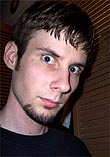|
|
This topic comprises 3 pages: 1 2 3
|
|
Author
|
Topic: grounds for dissmissal
|
|
|
|
|
John Pytlak
Film God

Posts: 9987
From: Rochester, NY 14650-1922
Registered: Jan 2000
|
 posted 12-12-2002 11:50 PM
posted 12-12-2002 11:50 PM





"Do it once, shame on you. Do it twice, shame on me."
In other words, if you make a mistake twice, it's still possible that I'm not training you properly. Everyone makes mistakes, and may repeat them if there is a lack of skill or understanding. But...
"Three strikes and you're out."
If after proper training, you still don't learn from your mistakes, you're out. Trashing three prints through your own negligence would not be acceptable, and it's time to look for another job.
If those "numerous little mistakes" kept happening, and were the reason a big show was lost or a print trashed, there's a square peg in a round hole.
| IP: Logged
|
|
|
|
|
|
|
|
Scott Norwood
Film God

Posts: 8146
From: Boston, MA. USA (1774.21 miles northeast of Dallas)
Registered: Jun 99
|
 posted 12-13-2002 09:48 AM
posted 12-13-2002 09:48 AM





Agreed with the majority. If the guy is obviously trying hard, but is making simple mistakes due to poor training, then the problem is with the trainer and with whoever decided to schedule someone without much experience to work on busy nights.
On the other hand, if the guy is clearly a goof-off and isn't interested in learning how to do the job right (which is usually indicated by making the same mistake multiple times), then he should be "directed toward other career opportunities" (i.e. fired).
Everyone will make occasional mistakes, and as long as they are treated as learning experiences and don't involve significant film or equipment damage, they can be positive experiences. Obviously, the best and most experienced operators (who are less likely to have problems) should be working on the "big" nights, though. A manager who schedules "the new guy" to run widely anticipated films on their opening weekend (when interlocks, etc. are most likely) is just asking for print damage and angry customers.
| IP: Logged
|
|
|
|
Thomas Procyk
Phenomenal Film Handler

Posts: 1842
From: Royal Palm Beach, FL, USA
Registered: Feb 2002
|
 posted 12-13-2002 12:22 PM
posted 12-13-2002 12:22 PM




Add to the "grounds for dismissal" not admitting to the mistakes you have made. If someone keeps scratching prints or causing brainwraps, yet the claim "it wasn't me" when it clearly was, they should be fired for lying.
We had a situation like that with one of our booth employees. He would ALWAYS manage to emulsion scratch a print on his shift. We got to the point where none of our prints were scratched in the entire theater. He works a shift, a print gets scratched. "It wasn't me man! That was like that when I came in! Don't try and blame me for that crap!!" Since I was the one that worked the shift before him (unbeknownst to him) not only did he lie to my face, but accused ME of doing the damage he did!! ![[Mad]](mad.gif)
Then there are those people who don't write down problems in the booth log in fear of getting in trouble for them. We had a tech come in to fix a platter deck that was continuously throwing prints. The platter deck still wasn't fixed at that point, (no one wrote in the log if it was or wasn't) and someone ran a print which was thrown, and they didn't log it. Next shift, assuming the platter was fixed, another print was run, and thrown as well.
THOSE are the people who should be fired. Not willing to admit to mistakes, and in turn not willing to learn how to prevent them.
=TMP=
| IP: Logged
|
|
|
|
|
|
Leo Enticknap
Film God

Posts: 7474
From: Loma Linda, CA
Registered: Jul 2000
|
 posted 12-14-2002 06:06 PM
posted 12-14-2002 06:06 PM





Human beings make mistakes: that's how God designed us. That's why in an aircraft that carries paying passengers, international law says that you have to have two qualified pilots on board, one double-checking what the other is doing. In operating theatres you have to have at least two qualified surgeons present whenever a patient gets cut up. In other words, really safety-critical procedures are done by two professionals, one of whose job is to catch any mistakes made by the other. It's the best system we have for reducing the risks of human fallibility to rock bottom.
Projecting films is not a safety-critical application, which is why most cinemas don't have two projectionists on duty at all times. The costs of doing this are far greater than the cost of accidently trashing a print every 2-3 years. My point is that even a well trained and experienced projectionst is capable of making a mistake, and should not be lynched for so doing. Lacing up a projector may not be rocket science, but in a multiplex environment it is a monotonous, repetitive task, but one in which even a minor, momentary error can scratch a print.
So the trick is to identify those who are fundamentally unable and unwilling to do the job properly, and get them out, but not to lynch someone who makes the occasional human error. It's not always easy to distinguish between the two situations, but I'd be inclined to give the benefit of the doubt until I'm convinced that I'm dealing with a problem person.
| IP: Logged
|
|
Gerard S. Cohen
Jedi Master Film Handler

Posts: 975
From: Forest Hills, NY, USA
Registered: Sep 2001
|
 posted 12-14-2002 06:56 PM
posted 12-14-2002 06:56 PM




quote:
In other words, really safety-critical procedures are done by two professionals, one of whose job is to catch any mistakes made by the other. It's the best system we have for reducing the risks of human fallibility to rock bottom.
Actually, in very large theatres in New York City at least, during nitrate/carbon arc/changeover days, a two man crew was normal, sometimes with a third operator, the foreman, present. I'm told this was standard practice at the Radio City Music Hall. The public safety WAS a critical factor, plus the importance of the presentation with very large audiences.
Since there was usually a stage show as well, lighting and stage crews
added many additional technical people. Sometimes in a booth I'd come across old IATSE projectionist yearbooks in which full-page advertisements were placed by the technical staffs of Broadway and Times Square theatres, with group photos of six to eight projectionists, since there were often two (sometimes three) shifts per day, and crews worked alternate days, for a total of four crews.
I've been told that at the RCMH it was not uncommon to run two prints simultaneously, so that in case of a film break or other mishap,the
safety projector would take over without missing a beat.
| IP: Logged
|
|
|
|
|
|
|
|
All times are Central (GMT -6:00)
|
This topic comprises 3 pages: 1 2 3
|
Powered by Infopop Corporation
UBB.classicTM
6.3.1.2
The Film-Tech Forums are designed for various members related to the cinema industry to express their opinions, viewpoints and testimonials on various products, services and events based upon speculation, personal knowledge and factual information through use, therefore all views represented here allow no liability upon the publishers of this web site and the owners of said views assume no liability for any ill will resulting from these postings. The posts made here are for educational as well as entertainment purposes and as such anyone viewing this portion of the website must accept these views as statements of the author of that opinion
and agrees to release the authors from any and all liability.
|

 Home
Home
 Products
Products
 Store
Store
 Forum
Forum
 Warehouse
Warehouse
 Contact Us
Contact Us




 Printer-friendly view of this topic
Printer-friendly view of this topic







![[Wink]](wink.gif)



![[Frown]](frown.gif)



![[Mad]](mad.gif)







